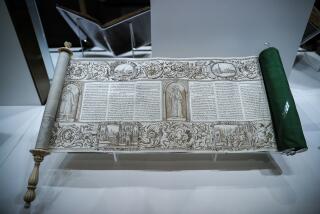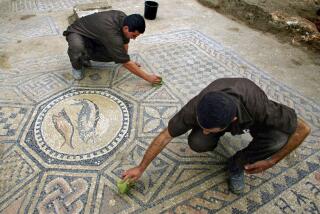Squaring Archeology With the Bible
- Share via
“One of the central paradoxes of the Bible is that, while it tells readers everything they need to know, they always want to know more,” writes Amy Dockser Marcus in “The View From Nebo,” a wholly fascinating study of what scientists actually find when they go in search of archeological evidence to corroborate Holy Writ. “They want to see Nebo for themselves, to climb to the top of the mountain, look out at Canaan, and see what Moses saw.”
Nebo, of course, is the site from which Moses was afforded a glimpse of the Promised Land on the eve of his death. The archeological diggings at the site of Mount Nebo in the Jordanian desert have revealed no sign of the historical Moses, but there is plenty of hard scientific evidence for a people that the Bible simply ignores.
The hills around Nebo were used as a burial ground by nomads 3,000 years before the supposed lifetime of Moses, and the oldest objects recovered from the site include axes and arrowheads dating back about 18,000 years to the Paleolithic Age. “Suddenly Nebo took on significance outside the pages of the Bible,” explains Marcus. “Here was an entire history that probably hadn’t been known during the biblical age.”
As Marcus expertly demonstrates, what began as “religious tourism” in the 5th century--pilgrimages by early Christians to sacred sites throughout the Holy Land--turned into “biblical archeology” in the 19th century as scholars began to search for evidence to corroborate the events reported in the Bible. But sometimes it seemed as if science mattered less than true belief among these archeologists, who were said to work with a shovel in one hand and a Bible in the other. “Discovery after discovery has established the accuracy of innumerable details,” exulted William Foxwell Albright, one of the leading archeologists of the early 20th century, “and has brought increased recognition of the Bible as a source of history.”
Nowadays, as Marcus shows us, such notions are mostly discredited, and leading archeologists are holding themselves to higher standards. “If you want to learn more about the Bible,” says a modern archeologist, “stop looking at the Bible.” Marcus leads us on an armchair expedition, pausing here and there to point out what archeology can and cannot prove about the figures and events depicted in the Bible.
Abraham and the other patriarchs, for example, no longer attract much attention from scholars: “They don’t regard Abraham as having anything historical to say,” says one archeologist. And the life of Moses and the saga of Exodus simply cannot be corroborated from extra-biblical sources: “There is no Egyptian text that even mentions the events described in the Hebrew Bible,” writes Marcus, “no artifact that records the Israelite sojourn in Egypt.”
Indeed, what has been dug out of the soil by archeologists sometimes contradicts the Bible or casts an entirely new light on its cherished assumptions. For example, the Bible depicts the Israelites as innovators who replaced the pagan be liefs of the Canaanites with a new faith and a new civilization of their own. But, Marcus reports, “for years, evidence has been mounting that the Israelites adopted and built on Canaanite culture, including cultic practices.”
A former Tel Aviv correspondent for the Wall Street Journal, Marcus has been a witness to the role that archeology plays in politics in the modern Middle East, where it is invoked in support of the rival territorial claims of Jews and Arabs. So hot are the controversies that have attached themselves to archeology in Israel and Palestine that the head of Bir Zeit University’s Institute of Archaeology--Albert Glock, an American archeologist who sought to “document the Arab contribution to Palestine’s cultural past”--was assassinated in 1992.
“The suspects ranged from Israeli secret service agents angry over his provocative archeological theories at a time of rising Palestinian nationalism,” explains Marcus, “to a Palestinian whose appointment he had supposedly blocked.”
“The View From Nebo” explores all the stresses and strains of Bible scholarship and exposes the white-hot controversies surrounding archeology in the Holy Land. Marcus also insists that the very experience of venturing into the biblical landscape and digging into the soil with one’s own hands can be an illuminating, even redemptive, experience.
On a visit to the oasis of Ein Gedi, a place that King David and Jesus of Nazareth may have seen with their own eyes, Marcus is struck by a revelation that puts her reportage into perspective: “Here the Bible can be seen in all its vastness and complexity, outside the narrow confines of any one religious group or dogma. This is the true Israel, one able to encompass a rich diversity, that sees its history as part of the wider mainstream.”
Jonathan Kirsch is the author of “Moses: A Life” and the forthcoming “King David: The Real Life of the Man Who Ruled Israel.”






